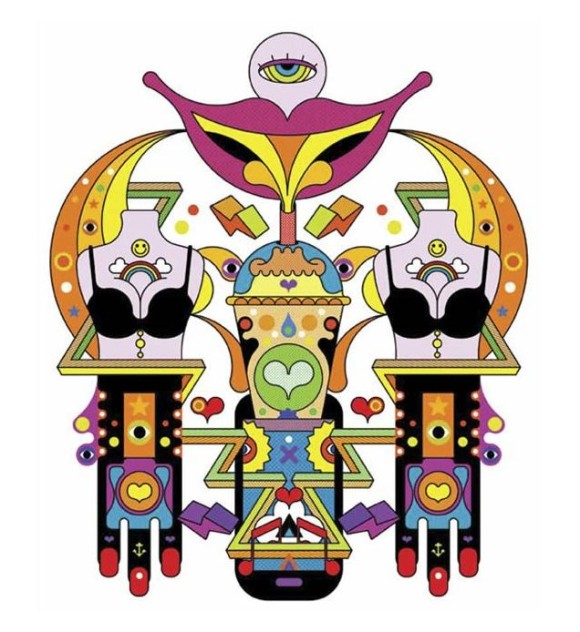I love Viewpoint magazine. It’s kind of an oddity – a lushly printed, highly visual and thinkful biannual magazine that charges £45 every issue (because it has no ads). You can barely find it anywhere, but it’s well worth seeking out, believe. It’s from the same stable as Textile View, View on Colour and Bloom, and it’s the first place I ever had anything published (at the tender age of 18). I’ve now been writing for Viewpoint for the last 15 years, off and on (including a stint as editor) and it’s a real treat to get to write for it still. I’ve previously featured extracts of Viewpoint stuff on this here blog (on Desire and Romance)and I recently did a thing about Play for the mag, so I thought I’d put an extract here for the internet’s delectation (Viewpoint is still stubbornly old media, so you can’t read it online).
Playing with the everyday
“Everyone wants to play”, says Sam Bompas, partner at food experience designers Bompas & Parr. “People have told themselves that they need to behave in a grown-up way, but in the right context they are happy to let go”. Bompas believes that the hugely popular interactive artworks by artists such as Olafur Eliasson and Carsten Holler have encouraged people to think about their environment in a new way, and delight in simple pleasures.
Just as Holler’s slides encouraged serious gallery-goers to reconsider what art can do for human interactions, Dutch design firm HIK Ontwerpers installed a slide at a rail station to help commuters reconsider their daily journey. The “transfer accelerator” was designed as a nice gesture for travelers, as well as a carefree way to speed up the morning commute and improve wellbeing in its run-down locale.
A competition to create a new bridge across the Seine also hopes to encourage Parisians to think differently about their environment. One of the winning designs is an inflatable trampoline bridge, which would allow people to bounce across the famous river.
Streetlife
For many, this kind of public play is part of a growing pursuit of extraordinary experiences in everyday life. Bompas believes, “Consumers need to have more creative lives now – it’s no longer good enough to just go to the pub on the weekend. People feel they have to do something fantastic, and get the pictures to prove it”, particularly for the benefit of their online social networks.
The result is an explosion of opportunities for play, as streets become playgrounds again – with games that are a whole lot more sophisticated than hopscotch. Berlin’s Playpublik, the Festival for Playful Public Spaces, used the city streets as part of a series of digital/real games around the city’s Computer Games Museum. Games ranged from parkour to micro-board games and collect-and-swap contests.
Meanwhile, in London, Hide&Seek’s 99 Tiny Games project suggested simple games via plaques mounted in 33 different locations around the city during summer 2012. The plaques instructed passers-by in games such as Rushing Roulette, where players spin round with eyes closed, then try to point at the centre of the plaque, and Twickers, a twig-pulling game, where the loser is the one whose twig snaps first.
Immersive playgrounds
Some forms of play adhere to the digital culture that spawned them, using real-life landscapes as just another platform in a multi-level game. Shadow Cities, a multiplayer online game, uses real streets as its playing surface. Smartphone users can form teams as they attempt to control the world of the game, which is overlaid on a real-world map, using GPS.
In London, Mudlark’s Chromarama game takes the geolocation-tagging and badge-winning appeal of Foursquare further by creating a game based on commuters’ routes around the city. The game uses travel data captured by players’ Oyster cards to award points for those who get off the tube early and walk to their destination, or those who go on quests to famous, or undiscovered, parts of the city.
Alex Fleetwood, director of social gaming agency Hide& Seek, believes this is only the beginning of online/offline play. “I think we’re going to see a deep integration of the video game culture as we presently understand it with older, more embodied, more situated forms of play – sports, parlour games, games in public spaces – linking everything that’s thrilling about computer-mediated games with everything that’s important about old-fashioned social play.
Conspicuous experience
Although much of the play renaissance is about the pursuit of release, variety and thrill, there’s also an element of competitive leisure. As Bompas comments, “The drive for experience is evolving. It’s not merely about going to a great event or getting involved with fun stuff, but making people stars in their free time. So play becomes a different kind of conspicuous consumption – it becomes conspicuous experience.”
After all, when money is tight, consumers are much happier to show off about things they’ve done, rather than things they’ve bought. But with brands, marketers and retailers focusing so heavily on the intangible value of “experience” over the last decade, palates for experience have become more sophisticated, and if a brand is going to get involved in play, they have to create an experience that’s truly remarkable, or just truly useful.